B ![]()
![]() p
p ![]() a
a![]() g
g![]() e
e![]() s
s![]()
![]() a
a![]() r
r ![]() e
e ![]()
![]() d
d![]() e
e![]() d
d![]() i
i![]() c
c![]() a
a![]() t
t![]() e
e![]() d
d ![]()
![]() t
t![]() o
o
J![]() e
e![]() f
f![]() f
f ![]()
![]() B
B![]() i
i![]() l
l![]() l
l![]() i
i![]() n
n![]() g
g![]() s
s
bracketing - In photography, shooting the same picture with the same lighting, using several exposure settings. This ensures that one of the shots will be the best of those possible. In lettering, the rounding off of the corners where a serif connects to a stem.
brad - A thin nail with a small head.
Brahma - In Hindu belief, the creator god. Brahma is often conceived as a member of the triad including Vishnu and Shiva.
Also see creativity.
brainstorming - A process for stimulating the creative production of ideas. Although it is often used by small and large groups of people, the brainstorming process can serve just one or two people too.
|
How to implement the brainstorming process in a small group: List and explain these four rules before starting: 1 No participant or observer of the process is permitted to criticize any of the ideas generated until a later time. 2 Even the craziest, most peculiar notions are great to consider out loud. 3 No limit to the number of ideas we'll consider is a good limit. We'll note even the least idea anyone comes up with. 4 Examples: Hunger, illness, and financial worries. Or, an educator, gallery, client, or grant-provider whose rigidity or negativity is obstructive. Check to be sure everyone is clear and comfortable with the rules. Designate one participant to be in charge of writing down every idea, the less editing of them the better. It is best when all participants can see the list at all times. When the number of ideas being added has slowed significantly, the process can end. The ending of brainstorming must be announced before the editing of the list of ideas should begin. Editing might begin then or be put off till later. |
|
Ideas for brainstorming exercises: 1
2
3
4
5 -- with or without a name; but if named, someone all support. |
Quote:
"The best way to have a good idea
is to have lots of ideas."
Linus Pauling (1901-), American chemist and winner of two Nobel
Prizes.
Also see art criticism, attitude, blocks to creativity, charette, choose, critique, culture, custom, derivative, different, effort, genius, imagination, incongruity, inspiration, interesting, motivation, muses, new, nuance, order, originality, text, and visualize.brainstorming
brass -  The bright
yellow or golden alloy of
copper and zinc,
in the proportion of about
two parts of copper to one part zinc. The zinc makes brass stronger
and harder than copper is alone. It is malleable
and ductile, though variations
in its composition
make its properties variable. Also, incised
plaques or tablets
made of brass, many of which were made as memorials to the dead during the Middle
Ages and Renaissance in Europe.
Many of these have become so popular
among people desiring to make rubbings (see frottage)
of them that casts of the
originals have been made to
use this way in order to preserve the originals.
The bright
yellow or golden alloy of
copper and zinc,
in the proportion of about
two parts of copper to one part zinc. The zinc makes brass stronger
and harder than copper is alone. It is malleable
and ductile, though variations
in its composition
make its properties variable. Also, incised
plaques or tablets
made of brass, many of which were made as memorials to the dead during the Middle
Ages and Renaissance in Europe.
Many of these have become so popular
among people desiring to make rubbings (see frottage)
of them that casts of the
originals have been made to
use this way in order to preserve the originals.
The alloy of copper and tin is bronze, while alloys with both zinc and tin are called gunmetals. Many of the alloys that are described as bronze are actually brass.
Examples of works in brass:

Attributed to Khorasan, Eastern Iran, Seljuq,
Brass Ewer, c. 1180-1210, repoussé
brass, inlaid with silver and bitumen,
height 15 3/4 x 7.5 inches
(40 x 19.1 cm), Metropolitan Museum of Art, NY. See ewer.

Peter Behrens (German), designer, manufacturer:
Allgemeine Elektricitæts Gesellschaft (A.E.G.), Germany,
Fan Model No. GB 1, 1908, painted cast iron and brass,
11 1/2 x 10 3/4 x 6 inches (29.2 x 27.3 x 15.3 cm), Museum of
Modern Art, NY. See design.
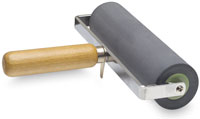
brayer - A tool used to roll ink onto a surface by hand, usually in block printing and in monoprinting.
braze - To join two pieces of metal (often mild steel) by heating to red heat and using a high-melting-point solder such as copper, zinc, or brass. This is known as hard soldering. A flux such as borax is necessary to aid the flow of the alloy.
Also see adhere, fuse, join, and weld.
brazen - Made of or like brass.
breakfast painting or breakfast piece - See ontbijt.
breathing - The expansion and contraction of paper, canvas, wood, and other absorbent grounds, in response to atmospheric conditions.
Also see buckle.
breccia - Marble, limestone, or other stone consisting of fragments of one or more stones within a natural cement of one or more contrasting colors.
(BRE-chə)
Also see quarry.
bric-a-brac - Small, usually ornamental objects valued for their antiquity, rarity, originality, or sentimental associations. Originally a French word.
(BRIK-ə-brak)
Also see bibelot, bricolage, confection, costume, decoration, fashion, gewgaw, jewelry, memorabilia, memory, realia, rhopography, and tchotchke.
bricolage - An improvised creation — or seemingly so — something made from whatever materials happen to be available. From the French bricole, meaning a trifle, and which the French used even earlier to mean catapault. Bricolage may be related to bric-a-brac.
Quote:
Also see Arte Povera, assemblage, collage, construction, coulage, découpage, farrago, femmage, frottage, fumage, marouflage, montage, parsemage, pastiche, photomontage, and pique assiette (also called picassiette).
bridge - To support the hand to keep it off of work in progress. A tool that supports an artist's hand away from the surface of a work may be called an artist's bridge, functioning much as does a mahlstick. A bridge typically rests beyond two opposite edges of a two-dimensional work, instead of just one, as a mahlstick does.
bright, brightness - The degree or intensity of lightness in a color.
A bright can also be a type of brush that is short and flat with a long handle. It is typically used with oil, acrylic and alkyd paints.
Also see candela, chroma, colorblindness, dark, deep, fluorescent colors, glossy, light, mat, pale, saturation, and value.
brilliance, brilliant - Brilliance is the brightness of a richly hued color. A color is brilliant when it has both high lightness and strong saturation. When prepared by mixing pigments, a large amout of a hue might be mixed with a small amount of white, but only to the degree that it remains richly hued. The opposite of brilliant colors in their value — much darker, but just as high in saturation — are called deep colors. Opposite to brilliant colors in saturation — little saturated, but just as high in lightness — are called pale colors. Opposite to brilliant colors in both value and saturation are dark colors.
Also see candela, glossy, luminosity, mat, pale, pastel, and value.
brindled - Streaked or spotted with a darker color.
Also see bleed, brushstroke, marbling, pattern, piebald, texture, and variegated.
bristle - See brush.
bristol board or Bristol board - A sturdy drawing surface used for many types of two-dimensional artwork, including lettering. It is available in several finishes, including a smooth plate finish and a medium vellum. It can be used on both of its sides.
Also see card or cardboard, illustration board, oaktag, and paper.
britannia - A silver-white alloy of tin, antimony, copper, and sometimes other elements, similar to pewter and once widely used in domestic utensils.
Also see metal.
broad manner - May refer to a bold manner of painting, or to a style of engraving in which the the engraved lines are thick and bold.
broadsheet - See broadside.
broadside - In printing, a large sheet of paper on one side of which is printed text with little or no graphic, often an advertisement or an announcement. Broadsides have often been folded. Also called a broadsheet. Both this printing sense of "broadside" and the naval one (the guns on one side of a ship) arose separately in the 16th century. Printed broadsides may have first been decrees intended for public posting, so they were necessarily printed on one side of large sheets of paper. Soon even matters printed on one side of smallish sheets were called broadsides — advertisements, for example, or the so-called "broadside ballads," popular ditties that people stuck on the wall to sing from. The broadside is closely related to the handbill, the brochure, and the pamphlet.
Examples:

American, an antislavery broadside advertising
a series of antislavery rallies, c. 1850s, Library of Congress,
Prints and Photographs Division, Washington, DC.
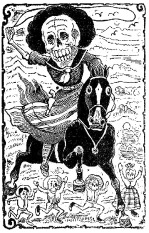
José Guadalupe Posada (Mexican, 1852-1913),
Calavera Revolucionaria, c.1910, central
panel of a larger sheet of images; 14 x 10 1/2. This print is
the central image from a larger broadside, printed from a zinc
plate etched by an acid bath. The image is first drawn onto the
zinc plate using a pen with a greasy type of ink that protects
the marks from the acid bath. The plate is then placed in a light
acid solution. The acid erodes into the plate leaving the drawn
lines standing in relief. José Posada was an artist during
a time of great political and social revolution. Posada was an
outspoken critic of the long ruling government of the dictator
Porfirio Díaz. He was an artist for the common people
of Mexico. Posada was also a political satirist. Many times local
and state governments were the objects of political satire. In
contrast, Emiliano Zapata, a popular hero of the Mexican Revolution,
was often portrayed by Posada as noble, upright, and honorable.
Also see ephemera and propaganda.
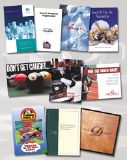
brochure - A pamphlet
or booklet. A very small book bound
 by staples
or stitches, or unbound as a trifold — one sheet of paper
folded in two places.
by staples
or stitches, or unbound as a trifold — one sheet of paper
folded in two places.
(pr. bro-SHəR)
Also see broadside, ephemera, handbill, pamphlet, and propaganda.
broken pediment - In architecture, a pediment, in which the cornice is discontinuous at the apex or the base.
browse image - In digital imaging, a small image, usually derived from a larger one. Often called thumbnail images or simply thumbnails. Browse images permit a user to view a dozen or more images on a single screen. Sometimes they are electronically made to be links to larger versions, and other images, texts, etc.
Also see lossless and lossy compression.
Brücke, Die - See Die Brücke.
brummagem - Making an imposing display but inferior and of little worth; showy but cheap.
Also see bad art, banausic, bibelot, bland, bric-a-brac, camp, decoration, decorative, decorative arts, gewgaw, kitsch, ornament, paint-by-number, realia, taste, and tchotchke.
brush cleaner - A compound used to clean oil, acrylic, lacquer, etc. from artists' brushes. May also refer to a vessel or holder used for brush cleaning. This last is also called a "brush washer," typically consisting of a metal cup surmounted by a sturdy wire coil designed to hold brushes suspended in a liquid solvent.
Also see brush washer.
brushstroke - The result of a brush loaded with paint or ink leaving some of that paint on a surface. Because brushstrokes can vary so greatly, their individual and cumulative effects are of great concern in the discussion of paintings.
Examples of paintings in which individual brushstrokes can easily be seen:
Claude Monet (French, 1840-1926), The Regatta at Argenteuil (Régate à Argenteuil), 1872, oil on canvas, 19 x 29 1/2 inches (48 x 75 cm), Musée d'Orsay, Paris. See Impressionism.
Roy Lichtenstein (American, 1923-1997), Little Big Painting, 1965, oil on canvas, 68 x 80 inches (172.7 x 203.2 cm), Whitney Museum of American Art, NY. This painting and the following screenprint humorously toy with the idea of making the brushstroke visible: depicting a gigantic one, using the flattened style of mass-produced cartoons. See benday and Pop Art.

Roy Lichtenstein, Brushstroke, 1965, screenprint
on paper, image: 56.5 x 72.4 cm, Tate
Gallery, London.
And, on the subject:
Also see Action Painting, dry brush, gesture, impasto, kitsch, line, linear, painterly, and palette knife.

brush washer - A device for keeping brushes suspended in water or thinner. The type pictured here has a spring coil that can hold the handles of several brushes of many sizes.
Also see brush cleaner.
brushwork - The particular manner in which an artist applies paint with a brush.
bubble diagram - A type of diagram which is a sketch made to propose an arrangement of spaces for the design of an environment or structure.
Also see architecture, plan, and section.
buckeye - Any kitsch which is painted in oil and produced for the mass market, characterized by sloppy yet facile rendition, and stereotyped, flamboyant, or sentimental treatment of subject matter, typically landscape. Although most commonly used to refer to such work produced during the second half of the nineteenth century, since the production of such painting has never ceased, the term might be applied to later examples as well. In the twentieth century, vast numbers of such pictures have been produced by assembly line methods. Recent examples are the works of Bob Ross (American, -1996), known for his television demonstrations, and Thomas Kinkade (American, 1958-).
(pr. BU-ki:)
Also see bad art, bland, calendar painting, kitsch, low art, paint-by-number, pastoral, picturesque, popular culture, rustic, sacral-idyllic scene, seascape, and still life.
buckle - Waves or bulges that appear in paper and canvas, generally from too much moisture and uneven drying.
Also see art conservation and breathing.
buckskin ceiling - What some American Indian artists call the invisible barrier that keeps them from rising to the top of their field. It is an artworld penchant for stereotype, a tendency to codify both traditional and contemporary forms of expression, a bias that makes space for traditional beadwork, buckskins and trading-post blankets, and ignores everything else. Newcomers to the Americas and their descendants have destroyed and displaced many American Indians. This has resulted in profound challenges to the cultural identity of contemporary Indians. The buckskin ceiling has been created partly by American Indians themselves, in that some American Indians have held fast to traditional images and meanings, while others have found new ones. But just as significant is the fact that the Indian art market, a multimillion-dollar global industry, is greatly controlled by non-Indians who impose their own ideas about what is valuable in American Indian cultures. "Buckskin ceiling" is an adaptation of the expression "glass ceiling" — an invisible barrier that keeps women from rising to positions of power.
Quote:
bucrania - In classical architecture, an ornament, usually in the friezes, having the form of an ox skull. (This is the plural form.)
Buddha - The supreme enlightened being of Buddhism [see depictions of him there], an embodiment of divine wisdom and virtue.
(pr. BOO-də)
buffer - A substance that restrains the acid migration of a material, or the act of using such a material this way. An acid-free papers are often used as buffers in matting, framing, displaying, wrapping, and storing art objects.
bug - A logo or logotype.
bulto - See santo.
bump up - In photography, to make an enlargement, also called a blowup.
bun-chin - In Japanese art tradition, a paperweight used in painting and calligraphy.
bunjinga - In Japanese art tradition, the Literary Men's style of painting.
bunraku - In Japanese art tradition, a kind of puppet theater in which each puppet is animated by three black-clad puppeteers. Bunraku has been practised in Japan at least since the 17th century.
school of Burgundy - The Flemish court artists under Philip the Bold of Burgundy, c. 1390 - c. 1420. The school practiced Flemish realism that was dominant in the Italian schools. From this grew the Gothic style. Among the most noted members were the Van Eyck brothers.
Example:
Jan van Eyck (Flemish, 1395-1441), The Ghent altarpiece, 1432, oil on panels (triptych), 4 feet 9 1/2 inches x 6 feet 9 inches, Cathedral of St. Bavo, Ghent, Cathedral of St. Bavo, Ghent. Details: Adam from left wing, Eve from right. Detail of lower central panel: Worshippers.
burgundy pitch - A viscous, slightly yielding, easy-to-melt resin used in repoussé to hold the work steady while it is being struck.
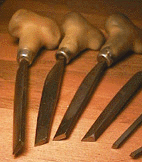
burin - A tool used in engraving or incising metal plates and in carving stone. A knob-like wooden handle which holds a metal shaft having a sharp beveled point with one size of several possible shapes, either flat, round, multiple, or elliptical. Also called a graver. May refer to the technique or style of an engraver's work.
(pr. BYOO-rən)
Also see chisel.
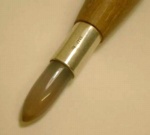
burnisher - A tool with
a hard smooth rounded surface
used for smoothing and polishing,
in metal work, ceramics
and gilding. Burnishers are
typically metal or stone. Typical of contemporary burnishers is the example illustrated here, an agate held in a ferrule, attached to a wooden handle.
An example of an object with a burnished surface:
![]()
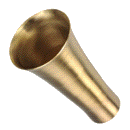
A fluted vessel, contemporary, burnished brass.
Also see etching.
burr - In engraving and drypoint, the ridge of metal plowed up by the burin, or graver, or needle, on the surface of a metal plate. A sharper tool generally produces less burr than a dull one. In a line engraving the burr is removed with a scraper to produce a clean line; in drypoint it is not removed, in order to produce the soft, blurred effect typical of that technique. Also, a burr can be the rough edge remaining on any material after it has been cast, cut, or drilled.

 bush hammer - A steel
stone-carving
tool, often with a large,
brick-like head, having two striking ends, each covered with rows
of pyramidal metal
points. Found in several sizes,
some with a longer, thinner head. Bush hammers are used to dress the surface
of stone by breaking down the rock surface, pounding and removing
small amounts at a time. The textures
achieved are typical among finish
in traditional French masonry.
Granite
bush hammer - A steel
stone-carving
tool, often with a large,
brick-like head, having two striking ends, each covered with rows
of pyramidal metal
points. Found in several sizes,
some with a longer, thinner head. Bush hammers are used to dress the surface
of stone by breaking down the rock surface, pounding and removing
small amounts at a time. The textures
achieved are typical among finish
in traditional French masonry.
Granite  and other igneous
rock is worked with a bush hammer, although now it is usually
an electrically motorized version. Also called by its French name,
"bouchard" or "boucharde."
and other igneous
rock is worked with a bush hammer, although now it is usually
an electrically motorized version. Also called by its French name,
"bouchard" or "boucharde."
Also see ballpein hammer, claw hammer, and mallet.
busshi - In Japanese art tradition, artists attached to Buddhist temples.
bust peg - The wooden support upon which a sculpture is modeled.
Also see banker.
busy - Describes an area of a picture that is overactive or confusing.
Also see horror vacui.
butcher paper - A type of paper which is available in various color, in rolls typically 36 inches wide. It has a fairly hard surface, with one side slightly smoother texture than the other. This sort of paper is useful for very large drawings, paintings, and collages. The colors of the inexpensive sort fade easily, but a more expensive"fadeless" kind is also available.
Also see construction paper, lightfast, permanent pigment, and tooth.
butcher's tray - A white enameled tray used as a palette for watercolor or acrylic paints. Butchers have been known to use them too.
butt - To adjoin without overlapping, as for example, two pieces of film or other material, or two colors of ink.
Also see align and alignment, butt joint, direction, edge, graphic design, juxtapose, and parallel.
butterfly - Two pieces of wood bound together to form a cross, suspended from an armature as an extra internal support for the weight of the modeling material.
butt joint - A right angle made by joining two pieces of butting material (especially of wood), broad edge to narrow edge, without mitering.
Also see adhesives.
 buttress
- A mass of masonry
or brickwork used as a support or brace counteracting the outward
(lateral) thrust
of an arch or vault.
A pier buttress is a solid
mass of masonry. A flying buttress is one which reaches over a
side aisle to support the
heavy stone roof of a cathedral.
buttress
- A mass of masonry
or brickwork used as a support or brace counteracting the outward
(lateral) thrust
of an arch or vault.
A pier buttress is a solid
mass of masonry. A flying buttress is one which reaches over a
side aisle to support the
heavy stone roof of a cathedral.
Example:
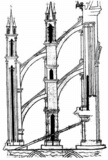
Villard de Honnecourt (French, Picardy, 13th
century), Reims Choir Buttresses, c. 1230-1635,
pen and ink over leadpoint
and stylus with occasional
additions in bistre wash on parchment, c. 240 x 160 mm. This
is the verso of the thity-second
leaf in a portfolio of 33 leaves, Bibliotheque Nationale,
Paris.
Also see aisle, architecture, clerestory, crocket, Gothic, Middle Ages, nave, trabeation, triforium, and vault.
https://inform.quest/_art